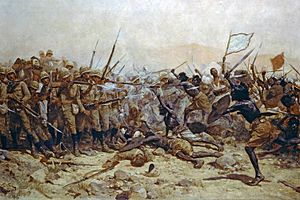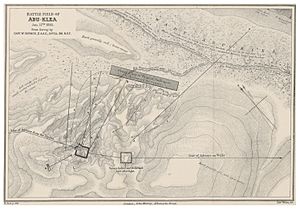Battle of Abu Klea facts for kids
Quick facts for kids Battle of Abu Klea |
|||||||
|---|---|---|---|---|---|---|---|
| Part of the Mahdist War | |||||||
 The Battle of Abu Klea by William Barnes Wollen |
|||||||
|
|||||||
| Belligerents | |||||||
| Commanders and leaders | |||||||
| Strength | |||||||
| 1,400 | 14,000 (3,000 engaged in the battle) | ||||||
| Casualties and losses | |||||||
| 76 killed 82 wounded |
1,100 killed, unknown wounded | ||||||
The Battle of Abu Klea was an important fight that happened in Sudan in January 1885. It was part of a bigger conflict called the Mahdist War. This battle saw British soldiers, known as the Desert Column, fight against forces led by Muhammad Ahmad, who was called the Mahdi.
The British soldiers were on a rescue mission. They were trying to reach General Charles George Gordon in Khartoum, who was surrounded by the Mahdi's army. The battle took place near a place called Abu Klea, which is also known as Abu Tulayh.
Contents
Why the Battle Happened
The British army had two main groups trying to reach Khartoum. One group, the River Column, traveled by boat along the river. The other group, called the Desert Column, marched straight across the Bayuda Desert. This was a faster but harder route.
The Desert Column was led by Sir Herbert Stewart. It had about 1,400 British soldiers. They were up against a much larger Sudanese force, estimated to be around 14,000 fighters.
The British Desert Column included different types of soldiers:
- 19th Hussars (soldiers on horses)
- Camel-mounted troops (soldiers riding camels) from different regiments like the Guards, Heavy, Light, and Mounted Infantry
- Detachments from other infantry (foot soldier) regiments
- A small Royal Navy Brigade with a special machine gun called a Gardner gun
- Four light field cannons
The Battle Begins
The British Desert Column reached Abu Klea just before sunset. Their commander, Sir Herbert Stewart, decided not to attack that night. Instead, they built a defensive camp called a zariba. This was a temporary fort made to protect them.
However, Mahdist snipers (shooters) on the nearby hills kept firing at them all night. The British soldiers suffered some injuries and deaths even before the main fight.
At dawn, Stewart ordered his troops to form a special formation called an infantry square. This was a strong defensive shape where soldiers stood in a square, facing outwards. It was very hard for enemies to break through.
The square slowly moved towards the wells to get water. The ground was rough and rocky. Suddenly, a huge Mahdist force, which had been hiding, attacked them!
Inside the Square
The British cannons were at the front of the square. The Naval Brigade, with their Gardner machine gun, was at the back-left corner. During the intense fighting, a gap opened up in the square.
Captain Lord Charles Beresford, who led the Naval Brigade, tried to move the Gardner gun to fire at the attackers. Colonel Frederick Gustavus Burnaby also ordered some camel troops to move out and help.
But the Gardner gun, which usually worked well, got jammed by the desert sand. As the crew tried to fix it, the Mahdist fighters, also known as Dervishes, rushed forward. Many sailors were killed or wounded.
The Dervishes pushed into the square. But they found the middle of the square full of camels, which blocked their path. The British soldiers quickly turned around and fired into the crowd of enemies and camels. They managed to push the Dervishes back out of the square and make them retreat.
The battle was very quick, lasting only about 15 minutes. The British lost 76 soldiers, and over 100 were wounded. The Mahdists suffered much heavier losses, with about 1,100 killed. Among the dead was Musa wad Helu, an important Mahdist leader.
A brave British officer, Colonel F. G. Burnaby, was killed by a spear. Gunner Alfred Smith showed great courage saving his officer and was awarded the Victoria Cross, Britain's highest military honor.
Two days later, there was another battle. Sir Herbert Stewart, the British commander, was badly wounded. He passed command to Sir Charles William Wilson.
What Happened Next
After the battle, the Desert Column continued its march towards Metemmeh. They fought another small battle on January 19, where they again pushed back the Mahdists.
On January 20, some boats sent by General Gordon reached the British camp. After some delays, Sir Charles Wilson finally set off towards Khartoum on January 24.
However, when they arrived on January 28, it was too late. Khartoum had already fallen to the Mahdi two days earlier, and General Gordon had been killed.
The British then left Sudan. The Dervishes of the Mahdi ruled Sudan for the next 13 years. Many people blamed the British Prime Minister, William Ewart Gladstone, for not sending help sooner. Even Queen Victoria was very angry about the delay.
The Battle of Abu Klea was remembered in poems and songs. One famous poem, "Vitai Lampada" by Sir Henry Newbolt, mentions the battle. Another poem, "Fuzzy-Wuzzy" by Rudyard Kipling, talks about the fighting skills of the Beja people, who were part of the Mahdist forces.
Today, a British army unit, the 176 Battery, still carries the honor title "Abu Klea" to remember the battle and the bravery shown there.
See also
- The Triumph of the Sun (2005 novel) by Wilbur Smith
- Khartoum (film)
- The Four Feathers, a film from 2002, where the battle is portrayed very different from reality and as a disastrous defeat instead of a victory.
Images for kids
-
Photograph of two Sikh soldiers of the Camel Corps, by Felice Beato, around 1884/85
-
The Egyptian Campaign Memorial in Brighton, East Sussex, England.





